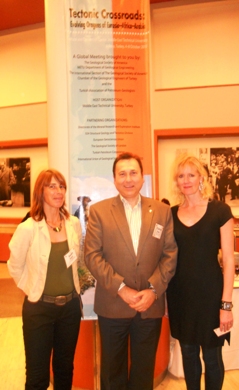
A melange of Turkish delights - Or the misadventures of two undergrads from the University of Portsmouth who take a journey into the depths of geological research, by Sarah Biejat and Nicola Willmot Noller
Geoscientist 21.03 Online Special April 2011
Hosted by the Middle East Technical University in Ankara, a five-day Global Meeting “Tectonic Crossroads: Evolving Orogens of Eurasia–Africa–Arabia” held immense attraction for two third-year undergraduates from the University of Portsmouth. Sarah was funded by the Geological Society and the University of Texas and, with Nicola aided by subsidised student registration fees, cheap flights and accommodation, they were able to attend the event in early October.
Sarah’s interest in the event was sparked by having spent her summer mapping in Greece. For Nicola, it was an opportunity to discover more of the current thinking behind tectonic and magmatic events, and to network!
At the opening evening drinks session it was easy to be awestruck by names from the academic papers that each had read. After all, the presence of undergraduates is a rare phenomenon at such events. Fortunately rescue came in the form of Kathleen Nicoll (University of Utah) a member of the conference Scientific Advisory Committee. Propelling them forward she insisted that there was little to fear.
Sarah: “From then on it was easy; everyone was so interesting and didn’t seem to care that I was an undergraduate. They included me in their discussions making me feel that my questions were valid.”
Nicola: “In fact, I was often told that we were likely to have valid contributions, given that we were less inclined to have been influenced by the multitude of fashionable ideas that float around the academic community at any one time. We could bring them back to earth with basics – though they may have said that just to be kind!”
Highlights were widespread: the conference covered themes as diverse as “Landscape, climate and archaeological evolution”, “Magmatism and evolving orogens”, “Sedimentary basin evolution and oil fields” and “Strike-slip and transform fault tectonics”.